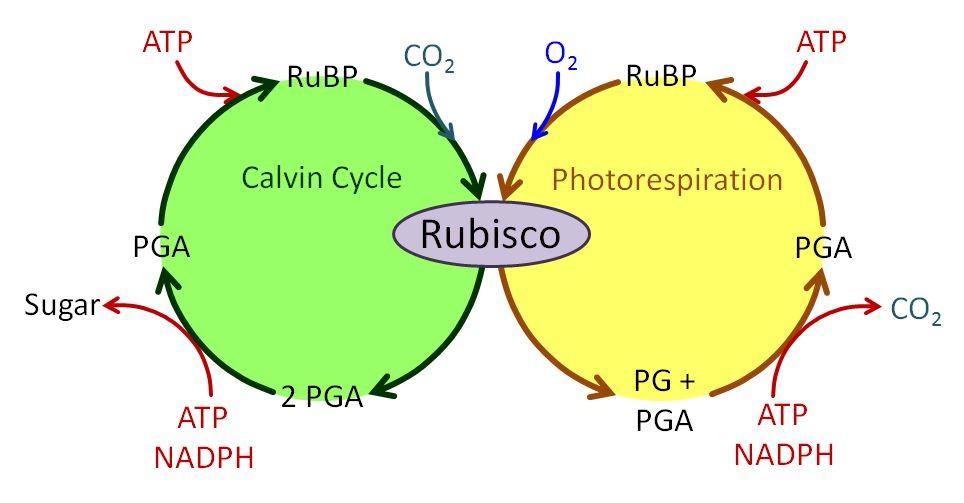| << Chapter < Page | Chapter >> Page > |
You can't have a light without a dark to stick it in." Arlo Guthrie, American musician
In a previous module, you learned about photosynthesis, the mechanism plants use to convert solar energy into chemical energy. The light energy captured is used to make ATP and NADPH, which is then used to reduce carbon from a simple form (CO 2 ) into a more complex form (sugars). The first step of the Calvin cycle is the fixation of carbon dioxide to RuBP, and the plants that only use this mechanism of carbon fixation are called C 3 plants. About 85% of the plant species on the planet are C 3 plants; some examples are rice, wheat, soybeans and all trees.
The process of photosynthesis has a theoretical efficiency of 30% (i.e., the maximum amount of chemical energy output would be only 30% of the solar energy input), but in reality the efficiency is much lower. It is only about 3% on cloudy days. Why is so much solar energy lost? There are a number of factors contributing to this energy loss, and one metabolic pathway that contributes to this low efficiency is photorespiration. During photorespiration, the key photosynthetic enzyme Rubisco (ribulose-1,5-bisphosphate carboxylase oxygenase) uses O 2 as a substrate instead of CO 2 . This process uses up a considerable amount of energy without making sugars ( [link] ). When a plant has its stomata open (CO 2 is diffusing in while O 2 and water are diffusing out), photorespiration is minimized because Rubisco has a higher affinity for CO 2 than for O 2 when air temperatures are below 30°C (86°F). However, when a plant closes its stomata during times of water stress and O 2 from photosynthesis builds up inside the cell, the rate of photorespiration increases because O 2 is now more abundant inside the mesophyll. So, there is a tradeoff. Plants can leave the stomata open and risk drying out, or they can close the stomata, thereby reducing the uptake of CO 2 , and decreasing the efficiency of photosynthesis. In addition, Rubisco has a higher affinity for O 2 when temperatures increase, which means that C 3 plants use more energy (ATP) for photorespiration at higher temperatures.

Evolutionarily speaking, why is photorespiration still around? One hypothesis is that it is evolutionary baggage from a time when the atmosphere had a lower O 2 concentration than it does today. In other words, when Rubisco first evolved millions of years ago, the O 2 concentration was so low that excluding O 2 from its binding site had little or no influence on the efficiency of photosynthesis. The modern Rubisco retains some of its ancestral affinity for O 2 , which leads to the energy costs associated with photorespiration. However, plant cell physiologists are discovering that there might be some metabolic benefits associated with photorespiration, which would help explain why this seemingly wasteful pathway is still found in plants. Adding to the dilemma is the fact that when plant geneticists “knock out” Rubisco’s ability to fix O 2 , Rubisco also loses its ability to fix CO 2 . It is possible that the active site of this enzyme cannot be engineered, by artificial or natural selection, so that it exclusively binds CO 2 and not O 2 .

Notification Switch
Would you like to follow the 'Principles of biology' conversation and receive update notifications?